
Attempts to apply nanotechnology in agriculture began with the growing realization that conventional farming technologies would neither be able to increase productivity any further nor restore ecosystems damaged by existing technologies back to their pristine state; in particular because the long-term effects of farming with “miracle seeds” in conjunction with irrigation, fertilizers, and pesticides, have been questioned both at the scientific and policy levels and must be gradually phased out.Nanotechnology in agriculture has gained momentum in the last decade with an abundance of public funding, but the pace of development is modest even though many disciplines fall under the umbrella of agriculture. One reason this may be is due to the fact that not much information about the safe use of nanomaterials in agriculture system has been accessible in recent years. 'Contemporary Suitability of Nanobionics in Agriculture' provides insight into the uses of nanomaterials in agriculture, which will be of particular use for agriculture personnel & beyond. The book includes an overview of nanobionics in agriculture, while also focusing on specific subjects such as recent advances, future outlook, biosafety & regulatory aspects, etc.Nanotechnologic intervention in farming has bright prospects for improving the efficiency of nutrient use through nanoformulations of fertilizers, breaking yield barriers through bionanotechnology, surveillance and control of pests and diseases, understanding mechanisms of host-parasite interactions at the molecular level, development of new-generation pesticides and their carriers, preservation and packaging of food and food additives, strengthening of natural fibers, removal of contaminants from soil and water, improving the shelf-life of vegetables and flowers, clay-based nano-resources for precision water management, reclamation of salt-affected soils, and stabilization of erosion prone surfaces, to name a few.